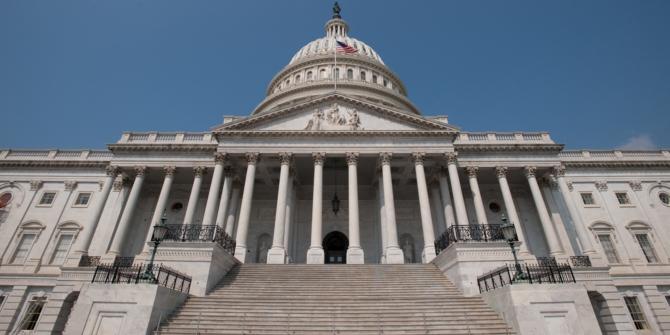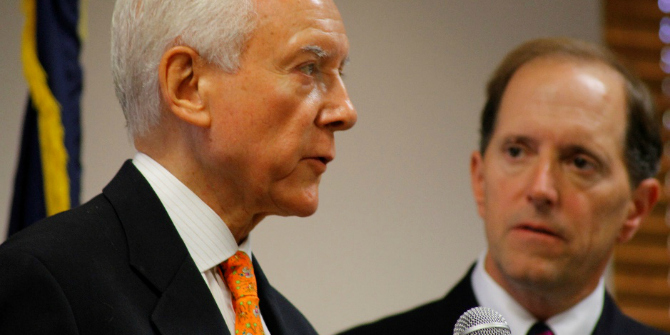

 This past weekend saw the death of John McCain, who had held his Arizona US Senate seat for more than three decades. Hanna K. Brant, L. Marvin Overby, and Theodore J. Masthay write that since 1919, more than 135 Senators have died whilst in office. They write that, though the frequency of these deaths has fallen dramatically since the 1960s, the passing of senior party members like John McCain can often have important implications for how power is wielded in the Senate.
This past weekend saw the death of John McCain, who had held his Arizona US Senate seat for more than three decades. Hanna K. Brant, L. Marvin Overby, and Theodore J. Masthay write that since 1919, more than 135 Senators have died whilst in office. They write that, though the frequency of these deaths has fallen dramatically since the 1960s, the passing of senior party members like John McCain can often have important implications for how power is wielded in the Senate.
Senator John McCain’s death this weekend from glioblastoma has made him the seventh senator in the 21st century to die while in office. While deaths in office are a relatively rare phenomenon in the contemporary Congress, historically they have been a significant source of turnover in the Senate. Of the 1,974 people who have served in the upper chamber, 301 have died in office, over 15 percent of the chamber’s total membership over time. Senator McCain’s passage provides an opportunity to review the history of mortality in office in the Senate and to reflect on its importance.
In a forthcoming article in Social Science Quarterly, we analyze deaths in the Senate between 1919 (the 66th Congress was the first to have its entire membership elected to office following the ratification of the 17th Amendment) and 2015. During this time period, 135 Senators died in office. Most of these deaths were due to natural causes, but a dozen were not, including six accidents (three in automobiles, three in airplanes), four suicides, and two assassinations (Huey Long [D-LA) in 1935 and Robert Kennedy [D-NY] in 1968). Overall, during this period the frequency of deaths in office dropped dramatically. As can be seen in Figure 1 below, the correlation between deaths and time between 1919 and 2015 is -0.71.
Figure 1 – Senate Deaths by Year, 1919-2015

Taking the historical perspective, over the past near century, deaths have accounted for a non-trivial percentage of change in Senate composition. The 135 deaths in this period compare to 324 electoral defeats, 256 retirements from public life, and 58 departures due to progressive ambition seeking another office. Most of the previous literature on this topic has taken a humorous (though sometimes macabre) approach. In their pun-filled article, Maltzman, Sigelman, and Binder title their concluding section the “post-mortem,” note that their “ghoulish” next step is to try to predict which members will die in office, and note that further research on the topic “will require much digging.” Similarly, Wuffle, Brunell, and Koetzle note with tongue in cheek that with increases in life expectancy, “Senators who manage to retain office will be nearly immortal.” And in the unpublished paper, “Air-Conditioning, Baseball Expansion, and the Immortal Washington Senators,” Keith Gaddie (2004, 7) concludes that the expansion of Major League Baseball from “ten cities through the 1940s to almost 30 cities in the 1990s” provides the best explanation of declining Senate mortality rates because the two institutions look alike: “slow to integrate, begrudging of letting girls play the game, and generally speaking,… wedded to old-fashioned rules and working in arcane and ancient looking venues.”
To be sure, particular deaths in office can and have had significant effects in and for the Senate. For instance, in 1947, Theodore Bilbo’s (D-MS) death from cancer ended a bitter and prolonged floor battle over whether or not to seat him following his re-election the previous year. Charges that Bilbo had incited racial riots during the campaign and illegally converted campaign donations for personal use threatened the fragile relationship between northern and southern branches of the Democratic party. In September 1969, the death of minority leader Everett Dirksen (R-IL) triggered a contentious leadership battle within the GOP, eventually won by “The Elder” Hugh Scott of Pennsylvania over “The Upstart” Howard Baker of Tennessee. And it was a spike in congressional deaths in the late 1920s that led to the creation of the Office of Attending Physician (first for the House in 1929, later extended in 1930 to the Senate, and later still to the Supreme Court), coordinated through the Navy.

“Flags at half staff – Prier Pour Paris” by John Sonderman is licensed under CC BY NS 2.0
At first glance, one interesting aspect of the data is that Democrats appear more likely to die in office than Republicans. Between 1919 and 2015, 77 sitting Democratic senators (16.8 percent of all Democrats to serve during this period) died in office compared with 58 Republicans (14.3 percent of the total GOP conference), even though GOP senators tended to be marginally older than their Democratic counterparts. While the partisan differential is significant, it may be more apparent than real. Once we account for a variety of other important factors (including age, tenure of service, ideology, previous vote share, serving in the majority, levels of activity as measured by bill sponsorship, and the expectation of being replaced by a governor of the same party), partisanship per se no longer shows an independent and significant effect. Which is not to say that there are not differences in death rates between Democrats and Republicans, because there are. In the main, Democratic Senators are less likely to die in office when they are more fully engaged in the process of legislating and sponsoring more pieces of legislation. In comparison, there is no similar engagement effect for Republican senators, but – though it may seem odd – they are significantly more likely than are Democrats to die when their state’s governorship (and hence the power to appoint a replacement) is in the hands of a co-partisan. At least at the margins, these results suggest an asymmetry between the parties in terms of Senate careers and morbidity patterns, with Democrats being motivated and influenced more by internal dynamics in the chamber and Republicans more by the larger political environment (some similar dynamics have been tested for and sometimes found in studies of mortality on the US Supreme Court).
The political repercussions of Senator McCain’s death will not be known for a while, though presumably the loss of the fourth most senior majority party member of the chamber could have political and partisan implications in the days leading up to the midterm elections. As we contemplate the most recent death in a deeply divided Senate, it might be worthwhile to recall a death in office on the other side of Capitol Hill in 1931. On the eve of the New Deal, the death of Speaker Nicholas Longworth (R-OH) contributed to the Democrats’ ability to elect one of their own to the office during the 72nd Congress despite the fact that Republicans had won a majority of seats in the 1930 elections.
Please read our comments policy before commenting
Note: This article gives the views of the author, and not the position of USAPP– American Politics and Policy, nor of the London School of Economics.
Shortened URL for this post: http://bit.ly/2P9Tipc
About the authors
 Hanna K. Brant – University of Missouri
Hanna K. Brant – University of Missouri
Hanna K. Brant is a PhD student in the Department of Political Science at the University of Missouri. Her primary area of research is American politics, with an emphasis on Congress. She is currently interested in understanding how congressional staffers supplement congressional capacity to draft legislation and conduct oversight.
 L. Marvin Overby – University of Missouri
L. Marvin Overby – University of Missouri
L. Marvin Overby is a Professor in the Department of Political Science at the University of Missouri. His research and teaching interests are broad, and include both a number of topics in American politics as well as some in the area of comparative legislative analysis.
 Theodore J. Masthay – Wabash College
Theodore J. Masthay – Wabash College
Theodore Masthay is a Visiting Assistant Professor of political science at Wabash College. His main area of study is American politics, with a focus on legislative careers. In particular, he is interested in understanding the ways in which the career trajectories of Democrats and Republicans differ.





